Jide Li
A Simple yet Powerful Instance-Aware Prompting Framework for Training-free Camouflaged Object Segmentation
Aug 13, 2025Abstract:Camouflaged Object Segmentation (COS) remains highly challenging due to the intrinsic visual similarity between target objects and their surroundings. While training-based COS methods achieve good performance, their performance degrades rapidly with increased annotation sparsity. To circumvent this limitation, recent studies have explored training-free COS methods, leveraging the Segment Anything Model (SAM) by automatically generating visual prompts from a single task-generic prompt (\textit{e.g.}, "\textit{camouflaged animal}") uniformly applied across all test images. However, these methods typically produce only semantic-level visual prompts, causing SAM to output coarse semantic masks and thus failing to handle scenarios with multiple discrete camouflaged instances effectively. To address this critical limitation, we propose a simple yet powerful \textbf{I}nstance-\textbf{A}ware \textbf{P}rompting \textbf{F}ramework (IAPF), the first training-free COS pipeline that explicitly converts a task-generic prompt into fine-grained instance masks. Specifically, the IAPF comprises three steps: (1) Text Prompt Generator, utilizing task-generic queries to prompt a Multimodal Large Language Model (MLLM) for generating image-specific foreground and background tags; (2) \textbf{Instance Mask Generator}, leveraging Grounding DINO to produce precise instance-level bounding box prompts, alongside the proposed Single-Foreground Multi-Background Prompting strategy to sample region-constrained point prompts within each box, enabling SAM to yield a candidate instance mask; (3) Self-consistency Instance Mask Voting, which selects the final COS prediction by identifying the candidate mask most consistent across multiple candidate instance masks. Extensive evaluations on standard COS benchmarks demonstrate that the proposed IAPF significantly surpasses existing state-of-the-art training-free COS methods.
See Different, Think Better: Visual Variations Mitigating Hallucinations in LVLMs
Jul 30, 2025Abstract:Large Vision-Language Models (LVLMs) have demonstrated remarkable capabilities in visual understanding and multimodal reasoning. However, LVLMs frequently exhibit hallucination phenomena, manifesting as the generated textual responses that demonstrate inconsistencies with the provided visual content. Existing hallucination mitigation methods are predominantly text-centric, the challenges of visual-semantic alignment significantly limit their effectiveness, especially when confronted with fine-grained visual understanding scenarios. To this end, this paper presents ViHallu, a Vision-Centric Hallucination mitigation framework that enhances visual-semantic alignment through Visual Variation Image Generation and Visual Instruction Construction. ViHallu introduces visual variation images with controllable visual alterations while maintaining the overall image structure. These images, combined with carefully constructed visual instructions, enable LVLMs to better understand fine-grained visual content through fine-tuning, allowing models to more precisely capture the correspondence between visual content and text, thereby enhancing visual-semantic alignment. Extensive experiments on multiple benchmarks show that ViHallu effectively enhances models' fine-grained visual understanding while significantly reducing hallucination tendencies. Furthermore, we release ViHallu-Instruction, a visual instruction dataset specifically designed for hallucination mitigation and visual-semantic alignment. Code is available at https://github.com/oliviadzy/ViHallu.
* Accepted by ACM MM25
Stepwise Decomposition and Dual-stream Focus: A Novel Approach for Training-free Camouflaged Object Segmentation
Jun 07, 2025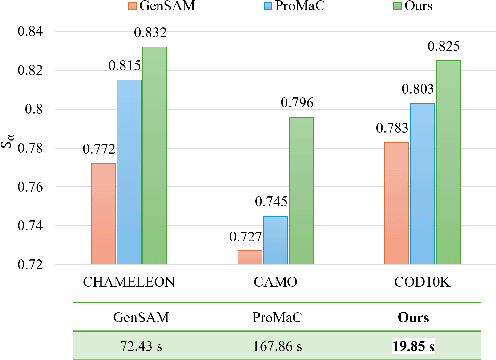
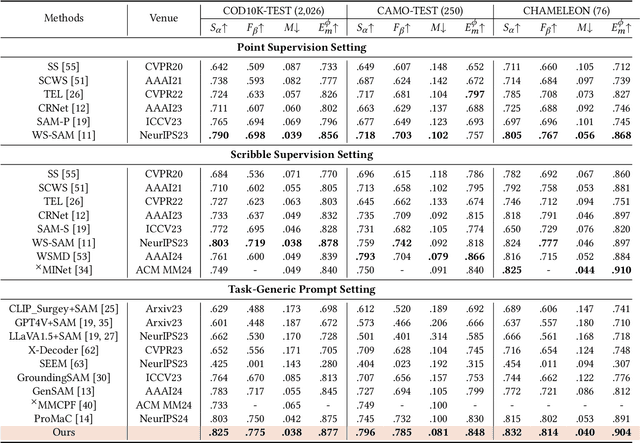

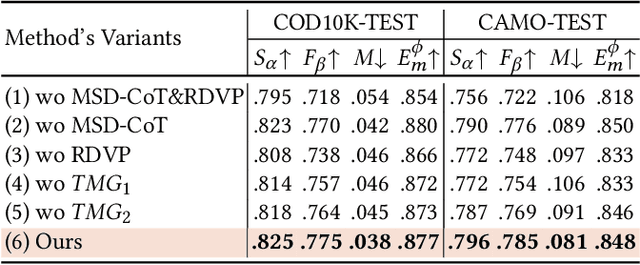
Abstract:While promptable segmentation (\textit{e.g.}, SAM) has shown promise for various segmentation tasks, it still requires manual visual prompts for each object to be segmented. In contrast, task-generic promptable segmentation aims to reduce the need for such detailed prompts by employing only a task-generic prompt to guide segmentation across all test samples. However, when applied to Camouflaged Object Segmentation (COS), current methods still face two critical issues: 1) \textit{\textbf{semantic ambiguity in getting instance-specific text prompts}}, which arises from insufficient discriminative cues in holistic captions, leading to foreground-background confusion; 2) \textit{\textbf{semantic discrepancy combined with spatial separation in getting instance-specific visual prompts}}, which results from global background sampling far from object boundaries with low feature correlation, causing SAM to segment irrelevant regions. To address the issues above, we propose \textbf{RDVP-MSD}, a novel training-free test-time adaptation framework that synergizes \textbf{R}egion-constrained \textbf{D}ual-stream \textbf{V}isual \textbf{P}rompting (RDVP) via \textbf{M}ultimodal \textbf{S}tepwise \textbf{D}ecomposition Chain of Thought (MSD-CoT). MSD-CoT progressively disentangles image captions to eliminate semantic ambiguity, while RDVP injects spatial constraints into visual prompting and independently samples visual prompts for foreground and background points, effectively mitigating semantic discrepancy and spatial separation. Without requiring any training or supervision, RDVP-MSD achieves a state-of-the-art segmentation result on multiple COS benchmarks and delivers a faster inference speed than previous methods, demonstrating significantly improved accuracy and efficiency. The codes will be available at \href{https://github.com/ycyinchao/RDVP-MSD}{https://github.com/ycyinchao/RDVP-MSD}
DuPL: Dual Student with Trustworthy Progressive Learning for Robust Weakly Supervised Semantic Segmentation
Mar 17, 2024



Abstract:Recently, One-stage Weakly Supervised Semantic Segmentation (WSSS) with image-level labels has gained increasing interest due to simplification over its cumbersome multi-stage counterpart. Limited by the inherent ambiguity of Class Activation Map (CAM), we observe that one-stage pipelines often encounter confirmation bias caused by incorrect CAM pseudo-labels, impairing their final segmentation performance. Although recent works discard many unreliable pseudo-labels to implicitly alleviate this issue, they fail to exploit sufficient supervision for their models. To this end, we propose a dual student framework with trustworthy progressive learning (DuPL). Specifically, we propose a dual student network with a discrepancy loss to yield diverse CAMs for each sub-net. The two sub-nets generate supervision for each other, mitigating the confirmation bias caused by learning their own incorrect pseudo-labels. In this process, we progressively introduce more trustworthy pseudo-labels to be involved in the supervision through dynamic threshold adjustment with an adaptive noise filtering strategy. Moreover, we believe that every pixel, even discarded from supervision due to its unreliability, is important for WSSS. Thus, we develop consistency regularization on these discarded regions, providing supervision of every pixel. Experiment results demonstrate the superiority of the proposed DuPL over the recent state-of-the-art alternatives on PASCAL VOC 2012 and MS COCO datasets. Code is available at https://github.com/Wu0409/DuPL.
Reasoning Structural Relation for Occlusion-Robust Facial Landmark Localization
Dec 19, 2021
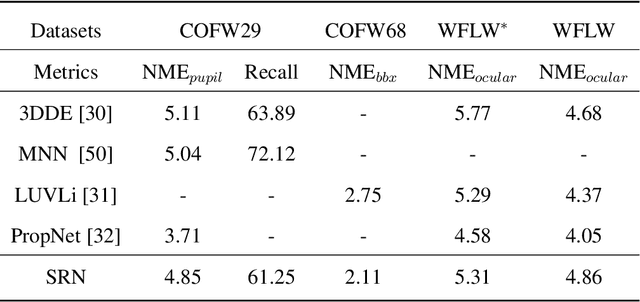

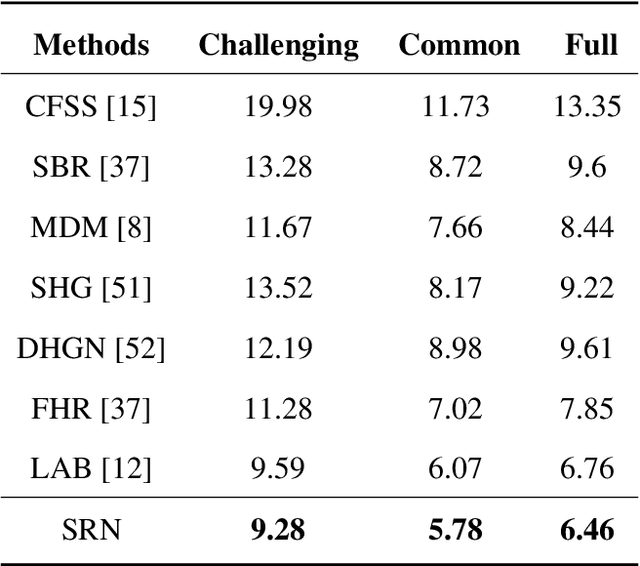
Abstract:In facial landmark localization tasks, various occlusions heavily degrade the localization accuracy due to the partial observability of facial features. This paper proposes a structural relation network (SRN) for occlusion-robust landmark localization. Unlike most existing methods that simply exploit the shape constraint, the proposed SRN aims to capture the structural relations among different facial components. These relations can be considered a more powerful shape constraint against occlusion. To achieve this, a hierarchical structural relation module (HSRM) is designed to hierarchically reason the structural relations that represent both long- and short-distance spatial dependencies. Compared with existing network architectures, HSRM can efficiently model the spatial relations by leveraging its geometry-aware network architecture, which reduces the semantic ambiguity caused by occlusion. Moreover, the SRN augments the training data by synthesizing occluded faces. To further extend our SRN for occluded video data, we formulate the occluded face synthesis as a Markov decision process (MDP). Specifically, it plans the movement of the dynamic occlusion based on an accumulated reward associated with the performance degradation of the pre-trained SRN. This procedure augments hard samples for robust facial landmark tracking. Extensive experimental results indicate that the proposed method achieves outstanding performance on occluded and masked faces. Code is available at https://github.com/zhuccly/SRN.
Unsupervised Learning of Multi-level Structures for Anomaly Detection
Apr 25, 2021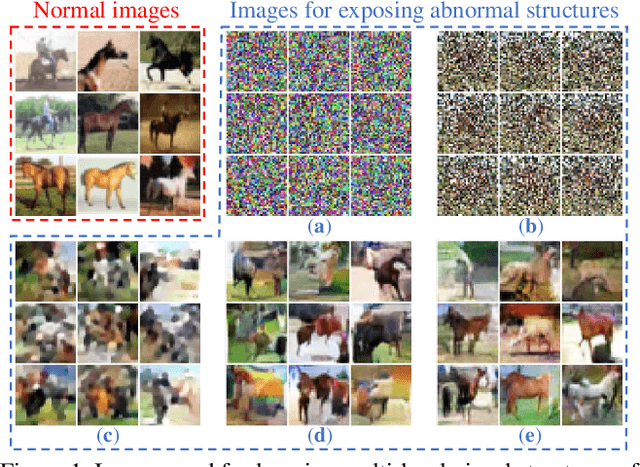
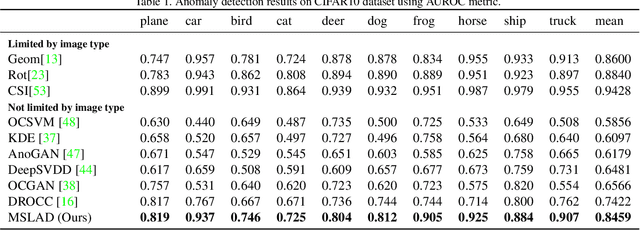
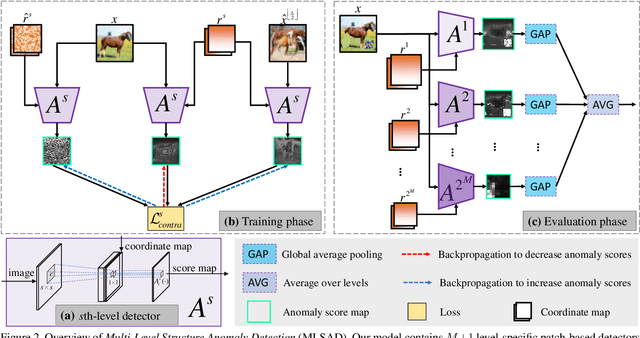
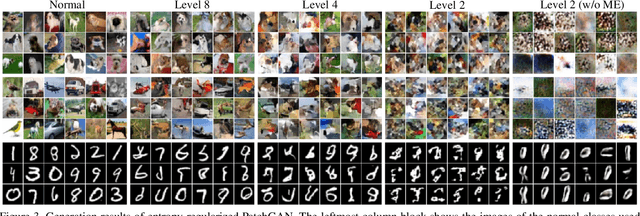
Abstract:The main difficulty in high-dimensional anomaly detection tasks is the lack of anomalous data for training. And simply collecting anomalous data from the real world, common distributions, or the boundary of normal data manifold may face the problem of missing anomaly modes. This paper first introduces a novel method to generate anomalous data by breaking up global structures while preserving local structures of normal data at multiple levels. It can efficiently expose local abnormal structures of various levels. To fully exploit the exposed multi-level abnormal structures, we propose to train multiple level-specific patch-based detectors with contrastive losses. Each detector learns to detect local abnormal structures of corresponding level at all locations and outputs patchwise anomaly scores. By aggregating the outputs of all level-specific detectors, we obtain a model that can detect all potential anomalies. The effectiveness is evaluated on MNIST, CIFAR10, and ImageNet10 dataset, where the results surpass the accuracy of state-of-the-art methods. Qualitative experiments demonstrate our model is robust that it unbiasedly detects all anomaly modes.
 Add to Chrome
Add to Chrome Add to Firefox
Add to Firefox Add to Edge
Add to Edge